
(a)
Interpretation:
Whether the carbocation formed by protonation of isoprene at
Concept introduction:
The delocalization of electrons results in the formation of resonance structure. The curved-arrow notation traces the flow of the electrons in a compound. This notation is used to derive the resonance structure.
Answer to Problem 15.65AP
The carbocation which is formed by protonation of isoprene at
Explanation of Solution
The given structure of isoprene is shown below.
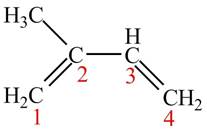
Figure 1
At the time of protonation at carbon
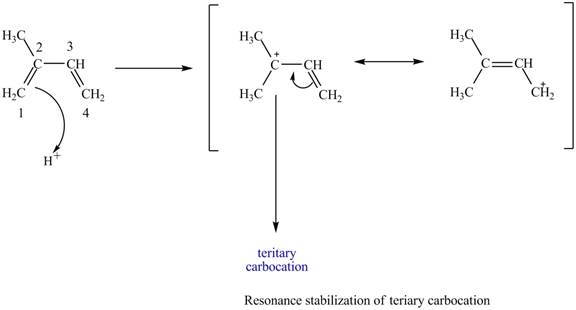
Figure 2
At the time of protonation at carbon
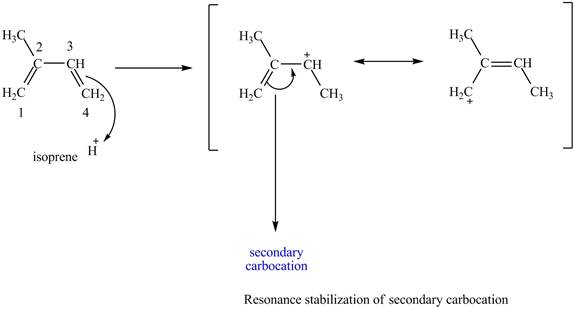
Figure 3
The more stable carbocation is selected on the basis of inductive effect as both carbocation at carbon
Therefore, tertiary carbocation formed at carbon
The carbocation which is formed by protonation of isoprene at
(b)
Interpretation:
The products that are formed by the addition of one equivalent of
Concept introduction:
The delocalization of electrons results in the formation of resonance structure. The curved-arrow notation traces the flow of the electrons in a compound. This notation is used to derive the resonance structure.
Answer to Problem 15.65AP
The products that are formed by the addition of one equivalent of
Explanation of Solution
The given structure of isoprene is shown below.
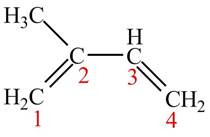
Figure 1
An isoprene always forms the
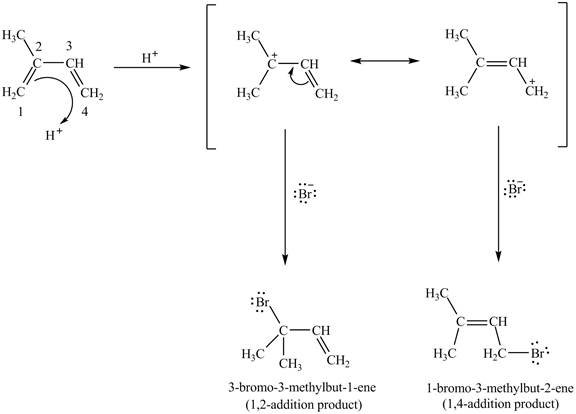
Figure 4
Therefore, the products formed by the conjugated diene, isoprene are
The products,
(c)
Interpretation:
The products that are formed the addition of one equivalent of
Concept introduction:
The delocalization of electrons results in the formation of resonance structure. The curved-arrow notation traces the flow of the electrons in a compound. This notation is used to derive the resonance structure.
Answer to Problem 15.65AP
The products that are formed the addition of one equivalent of
Explanation of Solution
In case of
The protonation of
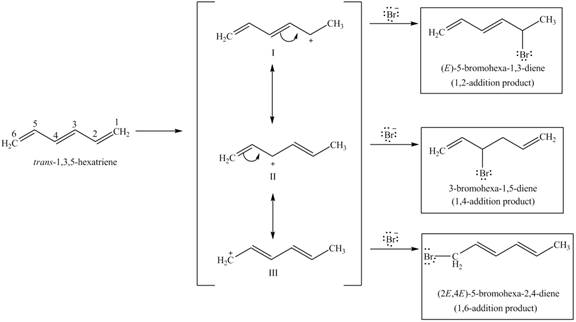
Figure 5
The reaction of
The products,
(d)
Interpretation:
The products which are formed in part (b) and (c) whether kinetically controlled products or
Concept introduction:
In the given conditions of the reaction, if the products of any reaction do not attain the equilibrium then the reaction is known as kinetically controlled reaction.
In the given conditions of the reaction, if the products of any reaction attain the equilibrium then the reaction is known as thermodynamically controlled reaction.
Answer to Problem 15.65AP
In part (b),
In part (c),
Explanation of Solution
The kinetically controlled products are formed much faster than thermodynamically controlled products. So, the
In part (b), the reaction of the given isoprene with
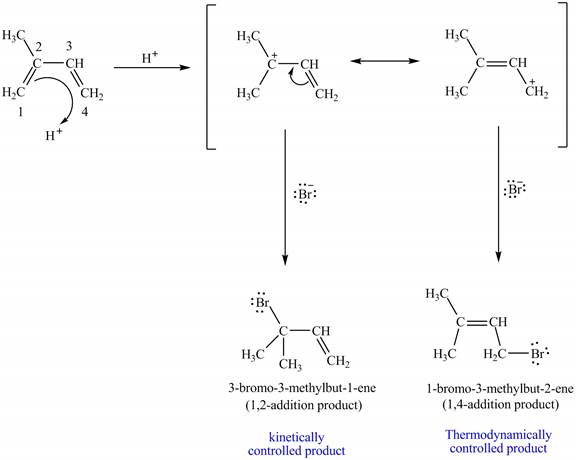
Figure 6
In part (c), the slowest addition is the
Therefore,
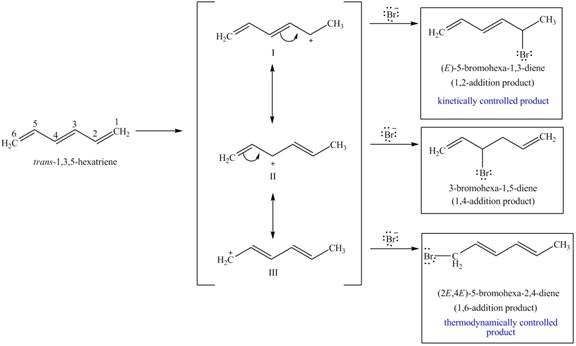
Figure 7
In part (b),
In part (c),
Want to see more full solutions like this?
Chapter 15 Solutions
Organic Chemistry
- EEZE LETCHUP ID Draw the most likely conjugate base resulting from this acid-base reaction. Include all lone pairs. Ignore inorganic byproducts. Drawing く NaOCH2CH3 :0: :0: 狗arrow_forwardAnswerarrow_forward2. Provide a clear arrow-pushing mechanism for the following reactions. Do not skip proton transfers, do not combine steps, and make sure your arrows are clear enough to be interpreted without ambiguity. a. CH3 Ph OEt هد Ph CH3 Hint: the species on the left is an ynolate, which behaves a lot like an enolate.arrow_forward
- b. CH3 H3C CH3 CH3 H3C an unexpected product, containing a single 9- membered ring the expected product, containing two fused rings H3C-I (H3C)2CuLi an enolatearrow_forwardb. H3C CH3 1. 2. H3O+ H3C MgBr H3Carrow_forwardPredict the major products of this reaction: excess H+ NaOH ? A Note that the first reactant is used in excess, that is, there is much more of the first reactant than the second. If there won't be any products, just check the box under the drawing area instead. Explanation Check Click and drag to start drawing a structure. © 2025 McGraw Hill LLC. All Rights Reserved. Terms of Use Privarrow_forward
- 1. For each of the reaction "railroads" below, you are either asked to give the structure(s) of the starting material(s) or product(s), or provide reagents/conditions to accomplish the transformation, as indicated by the boxes. a. NaOMe H+ .CO,H HO₂C MeOH (excess) MeOH H3C Br يع CH3 1. LiAlH4 2. H3O+ 3. PBг3 H3C 1. Et-Li 2. H3O+ -CO₂Me -CO₂Me OH CH3 CH3 ল CH3arrow_forwardPredict the intermediate 1 and final product 2 of this organic reaction: NaOMe ག1, ད།་, - + H You can draw 1 and 2 in any arrangement you like. 2 work up Note: if either 1 or 2 consists of a pair of enantiomers, just draw one structure using line bonds instead of 3D (dash and wedge) bonds at the chiral center. Explanation Check Click and drag to start drawing a structure. Х © 2025 McGraw Hill LLC. All Rights Reserved. Terms of Use | Parrow_forwardWhat is the total energy cost associated with the compound below adopting the shown conformation? CH3 HH DH CH3arrow_forward
- ΗΝ, Draw Final Product C cyclohexanone pH 4-5 Edit Enamine H3O+ CH3CH2Br THF, reflux H Edit Iminium Ionarrow_forwardHow many hydrogen atoms are connected to the indicated carbon atom?arrow_forwardIdentify the compound with the longest carbon - nitrogen bond. O CH3CH2CH=NH O CH3CH2NH2 CH3CH2C=N CH3CH=NCH 3 The length of all the carbon-nitrogen bonds are the samearrow_forward
